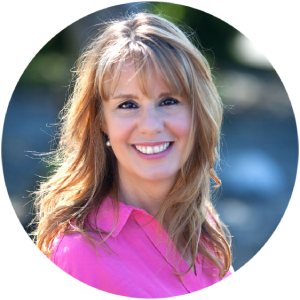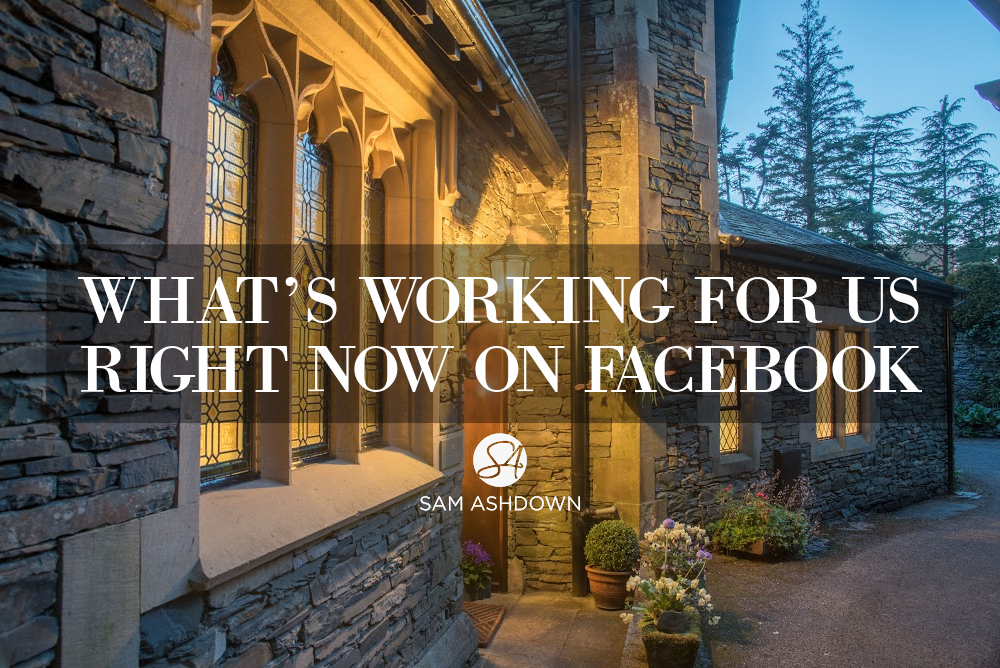The Power of Facebook
Social media is an essential part of your high value homes strategy, and Facebook should be at the top of your list. Currently, there is no platform more important and more powerful than Facebook. Two in three people in the UK has a Facebook account, which is 42 million users. 60% of over-thirties have a Facebook account, and the average age of a Facebook user may surprise you; it’s currently 40.5 years. Now teens see their parents and grandparents on Facebook, they don’t want to be on it, so the demographic is moving increasingly older and therefore increasingly affluent. Grandparents love using Facebook on their iPads, which means that attracting the downsizer market can be a very valuable part of your Facebook strategy, so long as you play the Facebook game by their own rules; rules that can be confusing and easy to fall foul of, as many agents do.
Let’s face it, most agents haven’t got a clue what they’re doing on Facebook, and break these rules often. Social media can be such a minefield – a scary, dangerous place. But don’t worry, I’m here to be your social media guide and to get you safely and effectively to the other side, where an abundance of new clients awaits.
The most commonly asked questions about social media my team and I get
Social media is such a big topic, with wide-ranging consequences for getting it wrong, but huge rewards when you get it right. Here’s what we get asked most often about how to use Facebook to grow an independent estate agency:
Q: What should I post?
I’m going to share with you my secret formula for choosing what to post on social. I created it years ago, and have been refining and testing it ever since. It’s super effective, and surprisingly simple, and it’s called Sam’s BLAST Formula.
My BLAST Formula works a bit like a diet. You can post outside this formula, just as you can have a treat every now again when you’re on a diet. But if you are constantly eating treats, and forgetting your fruit and veggies, your diet is not going to work. It’s the same with the BLAST Formula. A few posts every now and again outside your BLAST Formula isn’t going to hurt your following or social reach, but if your BLAST posts are in the minority, or you just aren’t using the Formula every day, you’re just not going to get the results you want from social, and that are entirely possible – if not probable – with the right strategy.
Here’s what Sam’s BLAST Formula means:
Behind the scenes
Local
A day in the life
Sneak peek
Tips and advice.
Let’s explore each one of these in turn, and how you can use them to grow your social media following and engagement:
Behind the Scenes
The most important of the BLAST elements; people love seeing behind the curtain of an estate agency. Here are some of our recent posts that did well:
- Our designer working on a watercolour painting for a brochure
- A photo of our photographer standing in a bath, going the extra mile to get the perfect shot
- Unboxing our latest bespoke brochures, fresh from the printer’s
- Phil taking in the view on a valuation visit (which could also be a ‘sneak peek’ post)
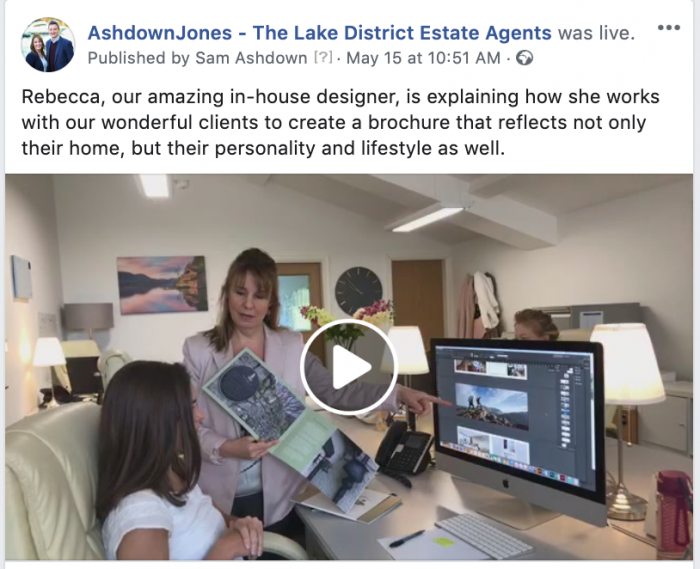
Local – connect with your local businesses and give them any support you can. It will come back to you in spades. For us, this has been:
- Afternoon office run to our favourite cafe for brownies
- A competition with a local florist
- A ‘pay it forward’ initiative with five local eateries
- An interview with the owner of a new shop in our town
- Photos of two of our team helping someone who had dropped his car keys in the lake
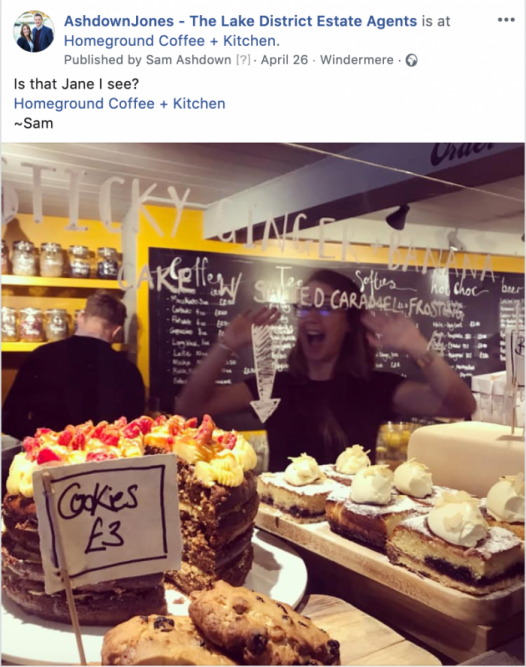
A day in the life – you, your team, doing whatever you do when you’re not being an estate agent. Here’s what we’ve posted recently:
- Live from a local river that had burst in recent heavy rainfall
- A photo of a plant I came across whilst walking in Scotland, asking what it was. (Turned out to be curly kale.)
- A live video of a water-logged car in local flash flood
- A full rainbow one morning on the way into the office
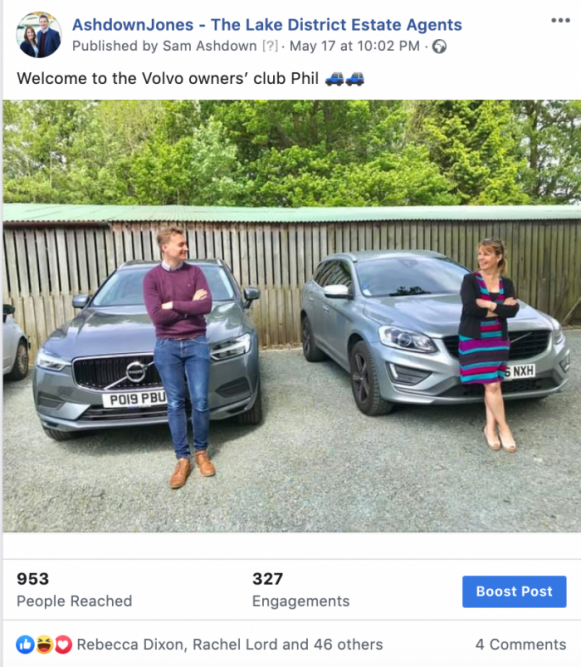
Sneak peek – a new property coming soon works well, to build interest in advance. Some of these posts did really well for us:
- The initials of a famous local, carved into the stones on a house over a hundred years ago
- A bath with a view, from a house coming to market soon
- Live from a twilight shoot (could also be a ‘behind the scenes’ post)
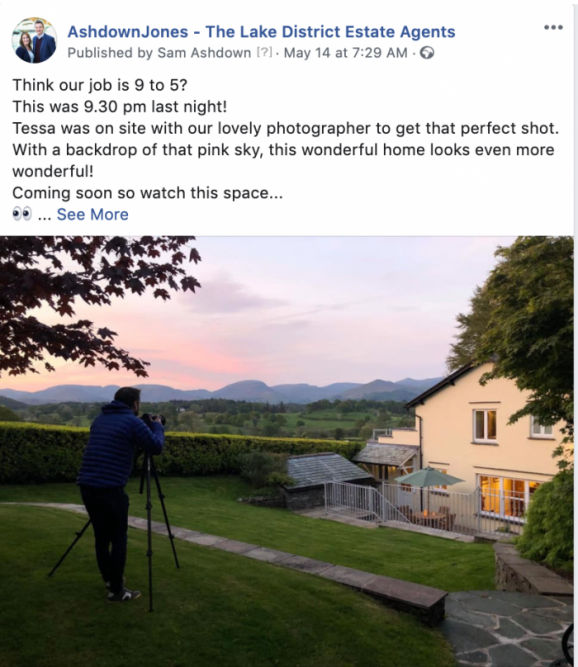
Tips and advice – from the tiniest household hack, to the most in-depth video Q&A, your audience will lap up your advice and consider you an expert. Here’s how we do it:
- A live “Ask AJ” video discussing ‘7 reasons to sell your house in spring’
- The link to our blog on the same topic
- Sam on a live video testing some sticker removal tricks from a bathroom suite
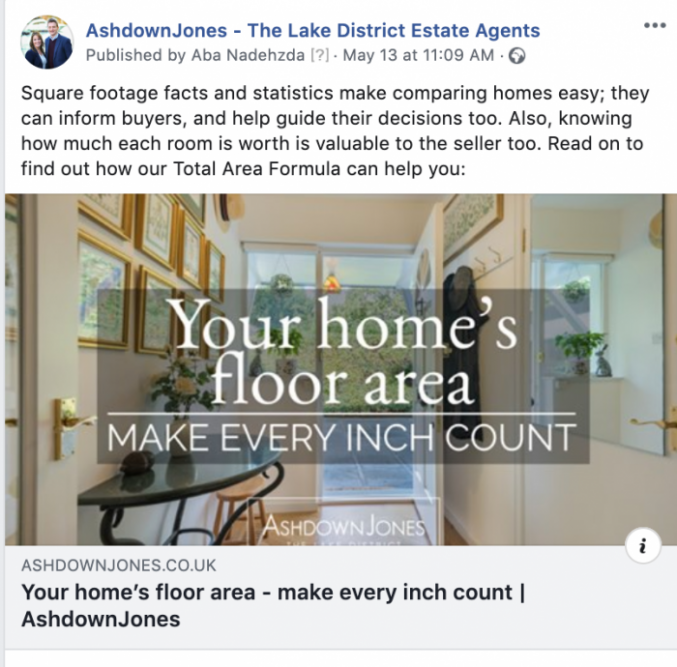
And that’s my miraculous BLAST Formula. Miraculous, because it works so well. It’s not hard to follow, but it’s really important that you do. Just get into the habit of posting frequently and consistently, and be patient – I promise you, this will grow your local, relevant followers, one person, and post, at a time.
You’re just trying to stop the scroll
When you post on your social media accounts, do you ever think about the person you’re trying to reach, what they are actually doing at that moment? She’s almost certainly busy. She’s not waiting by her Facebook newsfeed for you to create a new post. She might be checking her newsfeeds whilst waiting for the kettle to boil, or ironing Facebook open next to her, or watching tv. She might be doing all manner of things that don’t involve anything to do with houses or moving home, she’s just living her life in a million everyday ways. Her social feeds are a kind of running background commentary, she can dip into whenever she’s in need of some entertainment, or just a breather from her busy life. Our job is to make our posts so engaging, educative and entertaining that they stop her scrolling on past to find something she likes better.
Q: Who should manage my social media?
You, mostly. Just because your admin guy is under 20 years old doesn’t mean he can ‘do’ your Facebook. In fact, a poor social presence is much worse than no social presence. I would rather you didn’t have any social accounts if you weren’t going to spend quality time making them as good as they can be. Your social media accounts are arguably more important, and more relevant to your prospective clients, than your website. And you wouldn’t just hand over the responsibility for your web copy to one of your junior staff, would you?
Q: Which platforms should I use?
You literally have thousands to choose from. Wikipedia has a running list of the major active social networking sites, which as of the time of writing, numbers 212. Deciding to have an active presence on lots of social media sites will stretch your resources beyond their limit, I would suggest. And no, I don’t advocate auto-posting from social media management platforms. You need to spend your limited time and attention on a small number of sites that align with your brand, and you feel comfortable with.
Today, the four main platforms that work best for independent estate agents are:
This list is in order of importance, although Instagram and LinkedIn are interchangeable, if you’re more comfortable on LinkedIn than Instagram. You don’t have to post to all these platforms; I suggest you choose two. And if the BLAST Formula is completely alien to you, and would need time for you to implement it and get your team on board, then just start with Facebook, and get used to posting from the Formula every day. Only move on to a second platform once you feel confident you’re getting results with Facebook. If you’re not sure which platform to choose between LinkedIn and Instagram, let me ask you this: do you have a library of beautiful lifestyle images of houses you can post from? If so, Instagram is the best platform for you. But on the other hand, if you feel that your property photographs aren’t good enough to populate your Instagram feed, but you have great landlord content, then I suggest you use LinkedIn as your second platform of choice. Even though each of these four platforms has its own culture, style and feel, my BLAST Formula will work just as well on each. Post consistently and frequently on any of these four using the Formula, and your likes, your followers and your connections will rise.
Q: How often should I post?
Each of these four platforms, Facebook, Instagram, LinkedIn and Twitter, has its own ‘sweet spot’ when it comes to posting frequency. After trialling many different posting schedules across all of these platforms, these are the ones I now recommend to my clients:
- Facebook – three times a day (but more is great)
- Instagram – once a day
- LinkedIn – three times a week
- Twitter – no minimum frequency, but the best strategy is to engage in conversations in short bursts, three or four times a week at least, rather than use the platform as a broadcast medium.
Good things happen when you spend the time on your chosen platforms. One of my VIP clients, Georges Verdis from London Executive, was struggling with his Facebook page. His posting frequency was less than once a week, and his reach was so low, almost no one was seeing his posts anyway. He accepted a challenge from me to post from my BLAST Formula three times a day for a month, to see what would happen. What happened was that his likes shot up by 76, when they had actually been declining and his reach climbed to 50%, from nearly zero. Georges was delighted, and completely convinced by the efficacy of the BLAST Formula, which he still uses consistently and frequently today, and those figures continue to rise every week.
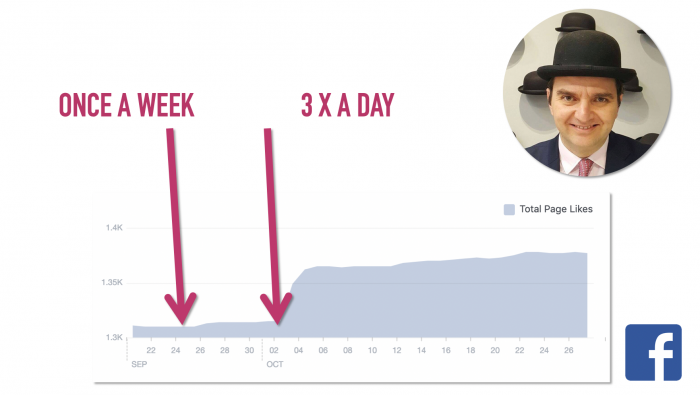
Q: Can I outsource it?
Getting help and support with your social media efforts will help to keep you on track towards your social media goals, but rather than choose to outsource this very important responsibility, I’d recommend you ‘insource’ your social media posting. Give all your team admin rights on all your social media accounts. We do this at AshdownJones, and it works really well. Our guidelines to them are simple: only post positive posts using the BLAST Formula. If you do need to outsource, you need to write the posts and set the schedule. I have a VA (virtual assistant) in the Philippines, and she shares our Tips and Advice content across our social media platforms. Whilst her English is excellent, I couldn’t expect her to write a compelling and relevant introduction to a blogpost link, so I write a short introductory paragraph and she adds this to each blogpost link as she posts.
Q: How can I get more likes?
Possibly the most asked question about social media…. Getting more likes, followers and connections can nice for your ego, but it may distract you from your true pathway, that of increasing engagement. That said, the number of likes, followers and connections you have is a measure of social proof, so let’s not discount it. Let’s look instead at how many of these you can expect to gain each year, if you are following my Blueprint. Here are my best answers:
Facebook – aim for between 500 and 1,000 new likes per year – I’ve looked at some accounts on Facebook that have been going for five years or more and they still have less than a hundred likes. If that’s you, you need to up your game. If you haven’t enjoyed a 500-plus increase in followers each year since you launched your Facebook page, then something needs to change, because ultimately, it means that the content you’re putting out isn’t engaging enough for people to follow you.
Instagram – aim for 250 to 500 followers per year – gaining new likes on Instagram tends to be more challenging than on Facebook; growth is slow, but engagement tends to be more meaningful.
LinkedIn – aim for 1,000 new connections per year – you can do this relatively easily by sending out targeted connection requests, and accepting most of the connection invites you receive in return.
Twitter – aim for 500 to 1,000 new followers per year – Twitter is more of a conversation platform these days, and far less of a broadcast medium, so it does require engagement to build likes. If it’s a platform you feel comfortable with, and enjoy engaging on with some frequency, then you should be able to reach 1,000 followers a year without trying too hard.
A word of warning: never, ever, EVER buy likes or followers. It’s just not worth it. I know how cheap they are, and I know how tempting it is, but they will always be fake and irrelevant. Vanity likes and followers will not achieve anything for your business, just spend the time and the energy in building a tribe of committed, relevant and loyal followers who genuinely care about what you have to say.
4 Ways to build your likes and followers
1. Earn your followers by following BLAST consistently – having worked with thousands of estate agents over the last decade and a half, I can promise you that the likes and followers you will gain by following my BLAST Formula are of the highest quality, and also the best engagers. It’s not a quick fix, and your social accounts won’t see an overnight success flood of followers, but you will earn your followers, one at a time, and they will stick with you during your social media journey if you show them respect.
2. In your business club – whenever you run a workshop or a session on social media, you can use it as a prompt to suggest a mutual follow from your attendees. When my club was smaller, we used to write everyone’s favourite social platform handle on the white board so everyone could follow one another. Now, when I suggest a follow, I can easily gain 20-30 new followers on whichever social platform we are discussing. The advantage of doing this in your group is that they will all be local, relevant likes, and a warm, loyal audience of people who already know and trust you
3. Competitions and giveaways– these are without fail our best way of boosting our likes on Facebook. In our last Christmas competition, we gained 700 new likes in just twelve days. We run competitions throughout the year, and involve local businesses, so we each benefit from the other’s audience.
4. Invite your ‘reactions’ – did you know that if someone reacts to a post on your page, but they haven’t yet liked your page, you can invite them to do so? You simply hover over the reactions to your post, and Facebook will bring up a list of the people who have reacted, with an option to invite them to like your page
Can you post too often on Facebook?
Agents often ask me this worried that they are going to annoy their Facebook fans. So I’m going to put this myth to bed, and explain why this is extremely unlikely (or even impossible) to happen. Firstly, we need to explore the sticky subject of ‘reach’.
Reach – Explained
Did you know that not everyone sees everything you post on Facebook, Instagram, Twitter or LinkedIn? It’s a metric called ‘reach’. Reach is simply how many people saw your post in their newsfeed, on desktop or mobile. On Facebook, this is denoted by a number next to ‘people reached’. Although the exact algorithm is a well-kept secret by Facebook, to stop companies ‘gaming’ the system, we do know that when you first post something on your Facebook page, it is first served to just a few people, to gauge how engaging it is to your particular audience.
If you look for a recent post with the lowest reach, that’s probably the number for your audience. If this initial round gets little interest, Facebook may not show your post to anyone else, and your reach will remain at this low number. However, if it gets interest and engagement, Facebook will then push it out to a wider audience. It’s possible – though difficult – to get to 100% reach with a post. This means that the number of people reached by your post and the number of page likes you have is the same. They may not be the same people though, but it’s a metric worth measuring and monitoring. The average reach for pages above 1,000 likes is around 10%. For much larger pages, it can be below 1%. We are currently averaging around 25%, so we’re beating the odds, but that’s only by consistently following the blueprint I’ve given to you. It works!
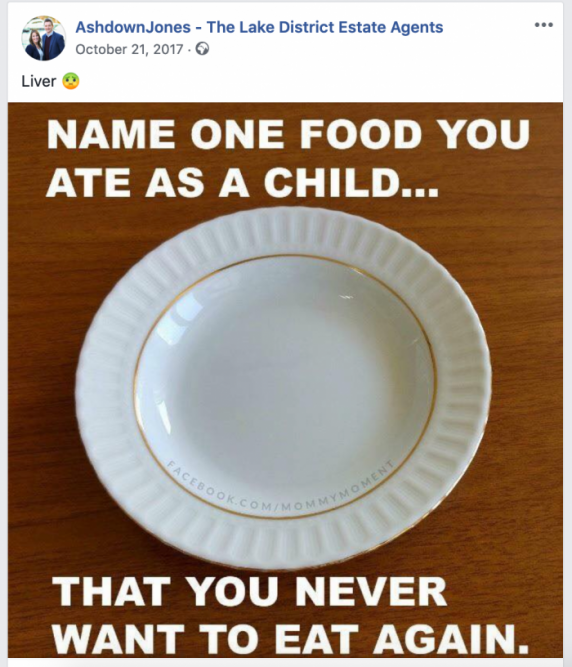
Our 1 million reach post
Our record post reached 1 million people, and literally went around the world several times. It was a fun post; nothing to do with the BLAST Formula. Did it benefit our page? It probably boosted our reach a little for the next few posts, but there was no benefit to inviting people who had reacted to the post to like our page, as they were not local or relevant in any way. It was just a bit of fun.
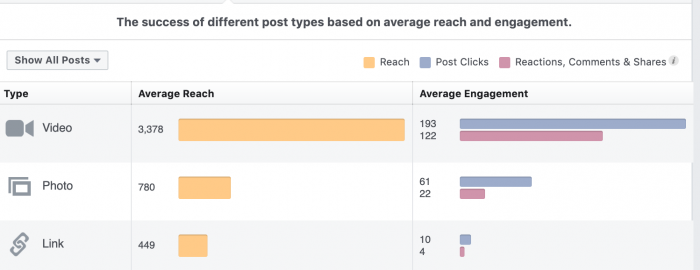
Reach on other platforms
The other social media platforms have pretty much the same system of reach, even though it could be called something else, like ‘impressions’. They also all have their own versions of ‘insights’, so you can monitor how well each type of post does on each platform you use.
On Instagram, you’ll need to have a business account in order to see your insights. If you only have a personal Instagram account, you won’t be able to see how well your page and posts are performing. It’s very easy to convert your personal account to a business account; just go to ‘settings’ and you’ll see it listed as an option.
Pay to Play
If only 25% of your audience see your posts, then how can you make sure your posts reach the remaining 75%? Simple: you need to pay to reach them. You can do this in one of two ways, the simplest being to ‘boost’ your post, which you can do right from the post itself. The second method is to create an advert from scratch in the Facebook Ads Manager dashboard. It’s a slightly more complex process, but it does give you more options, like being able to combine different audiences.
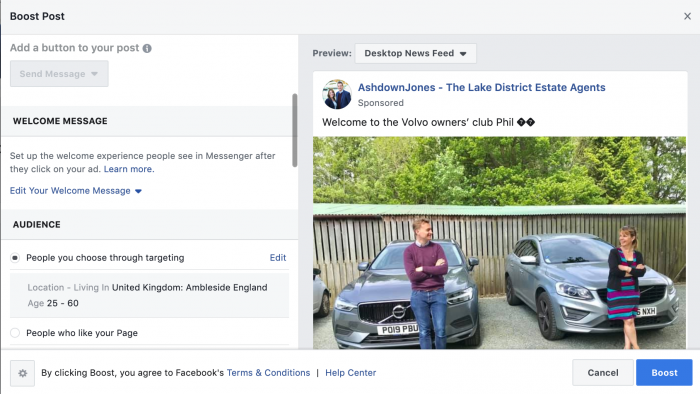
Engagement – what it is and why it matters
Engagement is your likes, loves, thumbs up, reactions, comments and shares, or any other engagement option your favoured platform offers. Engagement is a more relevant metric than reach because it’s a more accurate indication of how popular and engaging your posts are. When you create a post, ask yourself if it passes the ‘so what?’ test. If it isn’t interesting enough to your audience, it won’t stop them scrolling past it, and it certainly won’t elicit a reaction of any kind. Most social platforms closely correlate reach and engagement, using your engagement to determine your reach. If your engagement is high, so will your reach be.
Let’s whip your profile into shape
If either your personal and business profile isn’t great, it’s going to damage the other elements of your social accounts, including engagement and therefore reach. So, let’s whip it into shape now. Firstly, your profile photo should be your face. Not your kids, your dog, your car, your office, a for sale sign or anything except for your face. It doesn’t have to be stiff and professional, but nor should it be you with sunglasses on, drinking an umbrella-adorned cocktail.

Your profile versus your page
Lots of agents use their logo for their page profile, and I think it’s a mistake. Here’s why: it’s corporate, impersonal and no one wants to talk to a logo. Don’t forget that whatever you use for your profile picture is going to show in the newsfeed and you want your audience to react to what you post, so keep it real.
For example, my personal Facebook profile is a headshot of me, professionally taken, but outside, so it’s softer. My co-director Phil is currently using a photo of him with his family. Our AshdownJones’ page profile is us standing together, also a professional photo, but also taken outside, by the lake.
Your personal profile is for you as a person. Your profile allows you to accept friend requests and to send them to others too. You can distinguish between profiles and pages on Facebook, as a personal profile will have an ‘add friend’ button, whereas a page will have a ‘like page’ option.
Profile and page mistakes agents make
Whilst I was researching this section, I looked for ‘landscape gardeners’ on Facebook. Most of the results were for business pages, but there was a result for a personal profile – a ‘person’. This person was called Landscape Gardener.
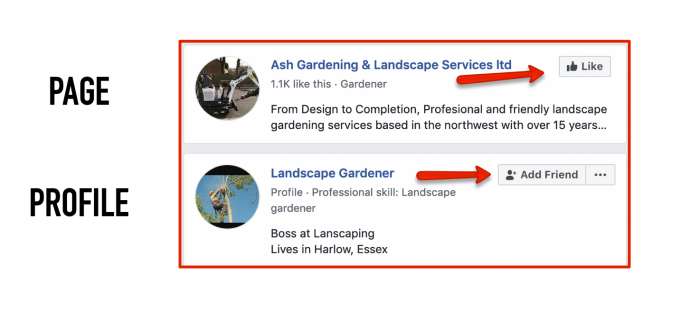
Page versus profile
So he’d set up his business as a personal page, with his first name ‘Landscape’ and his surname ‘Gardener’. Over the years, I’ve seen many independent agents who have made the same mistake, setting up their business page as a profile instead. Just type in ‘estate agents’ into a Facebook search and click on ‘people’, and you’ll see a long list of them appear. There are some major issues with using a personal profile as a business page:
- Facebook don’t like it, and will shut your profile down if they catch you, or if a competitor reports you.
- You can’t ask people to like your page, you have to ask them to friend request you instead.
- You don’t have access to any insights, to see which of your posts are performing well.
- You can’t use Facebook ads, or even boost a post.
- Not to mention that it looks unprofessional, and that you don’t know what you’re doing. (Even if this is true, don’t make this very rookie mistake.)
If you have set up your business page as a personal profile in error, you’ll need to request Facebook converts it. If you don’t have many ‘friends’, you’ll probably find it easier to simply start a new page now. Facebook are not the quickest to respond to support requests, and you could be building your new page with local, relevant likes whilst you’re waiting for them to come back to you, which could take months.
Here’s your social profile image checklist:
- Remember, no one wants to talk to a logo
- People reply to people
- Your fans want to connect personally with you
- They want to feel special knowing the business owner
- They’re looking for the social validation
- You can give that to them
Your cover image
This is the landscape image you see at the top of your Facebook page, your LinkedIn profile and your Twitter account. On Facebook, you can actually use your cover image to drive traffic to your website. On AshdownJones, we use our latest blog post image, and add a link and a short summary introduction in the image description. You can also use this image to drive people to your instant online valuation tool, if you’re using one. On Facebook, your new cover image will appear in your audience’s newsfeeds, so you get good reach with it. We change ours weekly, so it always looks fresh.
There’s no reason you can’t have a content cover image on LinkedIn or Twitter, you just can’t add a link and description, so you’ll have to add your link into your bio.
Making sense of Facebook insights
Whilst the four major social platforms I’ve recommended all have insights to some extent, I just want to explore Facebook here, as the most important of the four. The basic principles apply over the other three platforms, but may be called different terms, and monitor different metrics, so I suggest you spend time getting to grips with them all. Initially, Facebook insights is a good place to start.
To get to your Facebook insights, just go to your business page, and click on ‘insights’ option in the top menu. (If you can’t see it in your top menu, try clicking the ‘more’ button.)
Facebook insights: the 3 main elements to monitor
1. Page summary – at its simplest, green is good and red is bad. When I review our insights on this dashboard, I tend to change the time period using the dropdown box. You’ll see the default is seven days, but I usually change it to twenty-eight days, which I think is a more accurate reflection of your Facebook performance. If, for example, you’ve had a big promotion in the last couple of weeks, or maybe a competition that did well, your stats for the following week are naturally going to look poor. So using a twenty-eight day reporting period allows you to take a longer view, so you can see what you need to fix, and what you need to do more of.
2. The ‘whale’ – I call it this, because it looks like a whale – on most people’s insights, anyway. If you have a large overseas contingent to your audience, you won’t see a whale at all – possibly an eel, or even a camel…. But before we get too Freudian, let’s look at the information your whale can give you. Because this chart shows you something very interesting and useful: exactly when your page fans are online and active. You’ll find it in ‘insights’, then click on ‘posts’ and it will appear at the top of the page. A typical UK-based audience will give you a nice, neat whale shape, with the majority of your audience online and active on Facebook from six o’clock in the morning until about ten o’clock at night. In between, if you have dips and spikes, it could indicate your audience is mainly made up of employees, with limited access to Facebook, whilst if you have a pretty steady line of activity across the day, this could signify an audience of stay-at-home parents, or retirees.You can also monitor your audience activity by the days of the week. We tend to find that our active users are fairly consistent across each day, with a lowest point on Thursday, and the highest at the weekend. But the difference between these two is only about 1%, so it’s not something we really heed when deciding our posting strategy.

Something to keep in mind, is the times you personally are on your phone. I tend to pick up my phone at these times:
- First thing in the morning
- Breakfast
- Lunchtime
- Mid-afternoon
- Teatime
- Evening
- Just before I go to sleep
I don’t necessarily check my social media on all these occasions, and nor do I pick my phone up at these times every day, but it’s a fairly typical pattern for me to pick up my phone first and last thing in a day, plus any time I sit down to eat, or have a break. How much does my pattern mirror yours? The ‘whale’ will help you to determine whether your audience’s phone habits are anything like your own – or mine – and therefore you can construct your posting schedule around it.
3. Post types – which types of posts are most popular with your fans? To see this information, you need to be in ‘insights’, which is still in the Facebook dashboard, then click on ‘posts’, which is currently halfway down the left-hand menu. You’ll then see a list of the types of posts you post on Facebook, in the order of popularity each type has received on your Facebook page over the past 7 days. As I check on ours, it looks like this:
1. Video
2. Photo
3. Link
4. Status
Our videos are almost always our top type of content, and that’s why videos feature so heavily in our Facebook posting strategy. Second is photos, which we use on every post that’s not a video. We post links sparingly, mostly to our own content, or to a local event, but as Facebook tends to devalue a link off the site, (see the section on ‘Reach’), we keep these to a minimum. Status is a post type we rarely use, as it has no visual appeal.
This list of post types is what yours should look like too, more or less. If you’re not using video at the moment, you’re missing out on a huge opportunity to increase your reach and boost your page likes, so I suggest you make this a priority. If your ‘link’ and ‘status’ types are at the top of this list, it’s rarely because yours are popular, it’s much more likely to be the fact that you aren’t posting enough visual content – namely, videos and photos.
The ‘Facebook Pages to Watch’ feature
Did you know you could watch your competitor’s business pages, and check out how they are doing? Honestly, you can. But I warn you, it’s a little bit addictive. This feature is in the Insights section of a Facebook Page. It allows you to see their activity, engagement and audience growth. It’s really useful to pit yourself against your competitors, and use their metrics as a benchmark for your own. You need to have at least 100 likes on your page to use this feature, which you can reach by going to your Insights, and scrolling down to the bottom of the page, where – if you do have 100 likes – you’ll see the ‘Add Pages’ button. Interestingly, Facebook tell us that the owner of the page you choose to add to your watched pages will get a notification when you do, but I’ve found this not to be the case. Obviously, it’s better that they don’t, as most people have no idea this feature exists, and if you want to retain an edge over your competitors, you want to keep it this way. Having tested this on a few friends’ pages, I have yet to receive a notification, but test it out yourself too. Lastly, don’t forget that once they know how to do it, your competitors can watch your page too… which should spur you on to making sure your page is always top in their list.
What social media has meant to us
Social media plays a vital role for the growth of our agency; we just could not have built AshdownJones the way we have done, without Facebook in particular. Facebook is far more valuable to us than our website. Our website is great, but it’s not interactive; it doesn’t talk to people or engage them. It’s a static object, unlike Facebook. Facebook – and our other social media accounts – feels like an extension of us, of all the people who work in AshdownJones, and because of this,it is a true reflection of every single one of their wonderful personalities. The great news is, your competitors are probably doing it wrong, just as our competitors are doing it wrong. So, if you follow my guidelines and principles to get your social media looking the best it can, and engaging with the right audience, I promise you that your accounts will be at number one in your area.
Social media is just being social online
That’s it. Think of all the ways that you, personally, are social and sociable: chatting to someone in the supermarket aisle, out walking your dog, in a networking event or in a café. You’re being social. And the good news is that social media is just that, online.
Get in the habit of being social
Start now, spending time on your chosen channels, and getting a feel for what works and what doesn’t. Get comfortable with these platforms and with sharing your values, your personality and those of your audience, and grow your following with respect and enthusiasm. Just be social, truly social.
Over the years, I’ve learned that extraordinary success is not simultaneous, it’s sequential. (Hat tip to Gary Keller.) It’s about doing the things you may not want to do, day after day, month after month – and yes, even year after year. Because it’s inevitable that showing up consistently will bring you results. Show a little respect to your audience, because without respect for both the platform you’re on and the audience you’re trying to reach, your content will get ignored and rejected and that will lose your credibility and market attention. Social media marketing should not be a daily grind. It should be fun, interesting and an integral part of your working day and beyond. Have fun with it!
What to do now
This topic is one we cover in depth in my signature programme – How to Add £100k with High Value Homes. If you’d like a chat about whether you’d be a good fit to work with us, then let’s talk.
Speak soon 🙂
Sam
